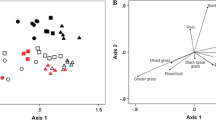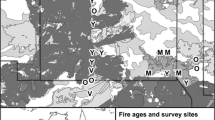Abstract
Although native herbivores can alter fire regimes by consuming herbaceous vegetation that serves as fine fuel and, less commonly, accumulating fuel as nest material and other structures, simultaneous considerations of contrasting effects of herbivores on fire have scarcely been addressed. We proposed that a colonial rodent, vizcacha (Lagostomus maximus), reduces and increases fire intensity at different stages in its population cycle in the semiarid scrub of Argentina. Specifically, we hypothesized that, when colonies are active, vizcachas create natural fire-breaks through intense grazing, generating over time patches of large unburned shrubs in grazed zones. In contrast, when colonies are abandoned, recovery of fine fuels and previous accumulation of coarse wood on colonies during territorial displays increases fire intensity, creating patches of high shrub mortality. To test these hypotheses, we estimated stem age of the dominant shrub (Larrea divaricata) and measured aboveground biomass in zones actively grazed by vizcachas and in ungrazed zones, and compared densities of live and dead shrubs on abandoned colonies and adjacent zones following fire. In active colonies, age and biomass of shrubs were much greater in grazed than ungrazed zones. In abandoned colonies that had been burnt, density of dead, burned shrubs was higher and density of live shrubs was lower than in adjacent zones. These results support our hypotheses and reveal a new interaction between native herbivores and fire, in which herbivores augment fire intensity by gathering fuel. Our findings indicate that, through opposing effects on fire, native herbivores enhance the heterogeneity of vegetation in woody-dominated ecosystems.


Similar content being viewed by others
References
Ayarbe JP, Kieft TL (2000) Mammal mounds stimulate microbial activity in a semiarid shrubland. Ecology 81:1150–1154
Badano EI, Villarroel E, Bustamante RO, Marquet PA, Cavieres LA (2007) Ecosystem engineering facilitates invasions by exotic plants in high-andean ecosystems. J Ecol 95:682–688
Barbour MG (1969) Age and space distribution of the desert shrub Larrea divaricata. Ecology 50:679–685
Bartel RA, Haddad NM, Wright JP (2010) Ecosystem engineers maintain a rare species of butterfly and increase plant diversity. Oikos 119:883–890
Bond WJ, Woodward FI, Midgley GF (2005) The global distribution of ecosystems in a world without fire. New Phytol 165:525–537
Boó RM, Peláez DV, Bunting SC, Mayor MD, Elía OR (1997) Effect of fire on woody species in central semi-arid Argentina. J Arid Environ 35:87–94
Branch LC (1993) Social organization and mating system of the plains vizcacha (Lagostomus maximus). J Zool 229:473–491
Branch LC, Villarreal D, Fowler GS (1994) Factors influencing population dynamics of the plains vizcacha (Lagostomus maximus, Mammalia, Chinchillidae) in scrub habitat of central Argentina. J Zool 232:383–395
Branch LC, Villarreal D, Hierro JL, Portier KM (1996) Effects of local extinction of the plains vizcacha (Lagostomus maximus) on vegetation patterns in semi-arid scrub. Oecologia 106:389–399
Branch LC, Hierro JL, Villarreal D (1999) Patterns of plant species diversity following local extinction of the plains vizcacha in semi-arid scrub. J Arid Environ 41:173–182
Bucher EH (1987) Herbivory in arid and semiarid regions of Argentina. Rev Chil Hist Nat 60:265–273
Byers JE, Cuddington K, Jones CG, Talley TS, Hastings A, Lambrinos JG, Crooks JA, Wilson WG (2006) Using ecosystem engineers to restore ecological systems. Trends Ecol Evol 21:493–500
Campos CM (1997) Utilización de recursos alimentarios por mamíferos medianos y pequeños del desierto del Monte. PhD dissertation, Universidad Nacional de Córdoba, Argentina
Carey EV, Callaway RM, DeLucia EH (1998) Increased photosynthesis offsets costs of allocation to sapwood in an arid environment. Ecology 79:2281–2291
Ceballos G, Davidson A, List R, Pacheco J, Manzano-Fischer P, Santos-Barrera G, Cruzado J (2010) Rapid decline of a grassland system and its ecological and conservation implications. PLoS ONE 5(1):e8562
Chew RM, Chew AE (1965) The primary productivity of a desert shrub (Larrea tridentata) community. Ecol Monogr 35:355–375
Chew RM, Whitford WG (1992) A long-term positive effect of kangaroo rats (Dopodomys spectabilis) on creosotebushes (Larrea tridentata). J Arid Environ 22:375–386
Davidson AD, Lightfoot DC (2006) Keystone rodent interactions: prairie dogs and kangaroo rats structure the biotic composition of a desertified grassland. Ecography 29:755–765
Davidson AD, Ponce E, Lightfoot DC, Fredrickson EL, Brown JH, Cruzado J, Brantley SL, Sierra-Cororna R, List R, Toledo D, Ceballos G (2010) Rapid response of a grassland ecosystem to an experimental manipulation of a keystone rodent and domestic livestock. Ecology 91:3189–3200
Dublin HT, Sinclair ARE, McGlade JM (1990) Elephants and fire as causes of multiple stable states in the Serengeti-Mara woodlands. J Anim Ecol 59:1147–1164
Eldridge DJ, Whitford WG, Duval BD (2009) Animal disturbances promote shrub maintenance in a desertified grassland. J Ecol 97:1302–1310
Erwin DH (2008) Macroevolution of ecosystem engineering, niche construction and diversity. Trends Ecol Evol 23:304–310
Fahn A (1990) Plant anatomy. Pergamon, UK
Flinn RC, Archer S, Boutton TW, Harlan T (1994) Identification of annual rings in an arid-land woody plant, Prosopis glandulosa. Ecology 75:850–853
Franco AC, de Soyza AG, Virginia RA, Reynolds JF, Whitford WG (1994) Effects of plant size and water relations on gas exchange and growth of the desert shrub Larrea tridentata. Oecologia 97:171–178
Grover HD, Musick HB (1990) Shrubland encroachment in southern New Mexico, USA: an analysis of desertification processes in the American southwest. Clim Change 17:305–330
Guevara JC, Stasi CR, Wuilloud CF, Estévez OR (1999) Effects of fire on rangeland vegetation in south-western Mendoza plains (Argentina): composition, frequency, biomass, productivity and carrying capacity. J Arid Environ 41:27–35
Hansell MH (1993) The ecological impact of animal nests and burrows. Funct Ecol 7:5–12
Hastings A, Byers JE, Crooks JA, Cuddington K, Jones CG, Lambrinos JG, Talley TS, Wilson WG (2007) Ecosystem engineering in space and time. Ecol Lett 10:153–164
Hierro JL (1999) Cold spots/hot spots: facilitation and interference of shrubs by a native herbivore in a semiarid scrub ecosystem. Master’s Thesis, University of Florida, USA
Hierro JL, Branch LC, Villarreal D, Clark KL (2000) Predictive equations for biomass and fuel characteristics of Argentine shrubs. J Range Manag 53:617–621
Hobbs NT, Schimel DS, Owensby CE, Ojima DJ (1991) Fire and grazing in the tallgrass prairie: contingent effects on nitrogen budgets. Ecology 72:1374–1382
Holdo RM, Holt RD, Fryxell JM (2009) Grazers, browsers, and fire influence the extent and spatial pattern of tree cover in the Serengeti. Ecol Appl 19:95–109
Huntly N, Inouye R (1988) Pocket gophers in ecosystems: patterns and mechanisms. Bioscience 38:786–793
Jackson JE, Branch LC, Villarreal D (1996) Lagostomus maximus. Mamm Species 543:1–6
Joern A (2005) Disturbance by fire frequency and bison grazing modulate grasshopper assamblages in tallgrass prairie. Ecology 86:861–873
Jones CG, Lawton JH, Shachak M (1994) Organisms as ecosystem engineers. Oikos 69:373–386
Keeley JE (1993) Utility of growth rings in the age determination of chaparral shrubs. Madroño 40:1–14
Knapp AK, Blair JM, Briggs JM, Collins SL, Hartnett DC, Johnson LC, Towne EG (1999) The keystone role of bison in North American tallgrass prairie. Bioscience 49:39–50
Laundré JW (1993) Effects of small mammal burrows on water infiltration in a cool desert environment. Oecologia 94:43–48
Laundré JW (1998) Effect of ground squirrel burrows on plant productivity in a cool desert environment. J Range Manag 51:638–643
Laws RM (1970) Elephants as agents of habitat and landscape change in East Africa. Oikos 21:1–15
Machicote M (2001) Facilitation-inhibition: burrowing owls and their hosts in central Argentina. Master’s Thesis, University of Florida, USA
Machicote M, Branch LC, Villarreal D (2004) Burrowing owls and burrowing mammals: are ecosystem engineers interchangeable as facilitators? Oikos 106:527–535
Moreno JM, Oechel WC (1991) Fire intensity effects on germination of shrubs and herbs in southern California Chaparral. Ecology 72:1993–2004
Moreno JM, Oechel WC (eds) (1994) The role of fire in Mediterranean-type ecosystems. Ecological studies, no. 107. Springer, USA
Myers RL (1990) Scrub and high pine. In: Myers RL, Ewel JJ (eds) Ecosystems of Florida. University of Central Florida Press, USA, pp 150–193
Norton-Griffiths M (1979) The influence of grazing, browsing, and fire on the vegetation dynamics of the Serengeti. In: Sinclair ARE, Norton-Griffiths M (eds) Serengeti: dynamics of an ecosystem. University of Chicago Press, USA, pp 310–352
Parras AM, Casadío S (2006) The Oyster Crassostrea? hatcheri (Ortmann, 1897), a physical ecosystem engineer from the upper Oligocene-lower Miocene of Patagonia, southern Argentina. Palaios 21:168–186
Reichman OJ, Seabloom EW (2002) The role of pocket gophers as subterranean ecosystem engineers. Trends Ecol Evol 17:44–49
Roques KG, O’Connor TG, Watkinson AR (2001) Dynamics of shrub encroachment in an African savanna: relative influences of fire, herbivory, rainfall and density dependence. J Appl Ecol 38:268–280
Ryan MG, Binkley D, Fownes JH (1997) Age-related decline in forest productivity: pattern and process. Adv Ecol Res 17:213–262
SAS Institute (1996) SAS/STAT software: changes and enhancement. SAS Institute, Cary, USA
Savage M, Swetnam TW (1990) Early 19th century fire decline following sheep pasturing in a Navajo ponderosa pine forest. Ecology 71:2374–2378
Smith CC, Reichman OJ (1984) The evolution of food caching by birds and mammals. Annu Rev Ecol Syst 15:329–351
Statzner BE, Fievet JY, Champagne R, Morel D, Herouin E (2000) Crayfish as geomorphic agents and ecosystem engineers: biological behavior affects sand and gravel erosion in experimental streams. Limnol Oceanogr 45:1030–1040
Troost K (2010) Causes and effects of a highly successful marine invasion: case-study of the introduced Pacific oyster Crassostrea gigas in continental NW European estuaries. J Sea Res 64:145–165
van Langevelde F, van de Vijver C, Kumar L, van de Koppel J, de Ridder N, van Andel J, Skidmore AK, Hearne JW, Stroosnijder Bond WJ, Prins HHT, Rietkerk M (2003) Effects of fire and herbivory on the stability of savanna ecosystems. Ecology 84:337–350
van Staalduinen MA, Werger MJA (2007) Marmot disturbances in a Mongolian steppe vegetation. J Arid Environ 69:344–351
Vasek FC (1980) Creosote bush: long-lived clones in the Mojave desert. Am J Bot 67:246–255
Villarreal D, Branch LC, Clark K, Hierro JL, Machicote M (2008) Alteration of ecosystem structure by a burrowing herbivore. J Mamm 89:700–711
Waldram MS, Bond WJ, Stock WD (2008) Ecological engineering by a mega-grazer: white rhino impacts on a South African savanna. Ecosystems 11:101–112
Weltzin JE, Archer S, Heitschmidt RK (1997) Small-mammal regulation of vegetation structure in a temperate savanna. Ecology 78:751–763
Weston CJ, Attiwill PM (1990) Effects of fire and harvesting on nitrogen transformations and ionic mobility in soils of Eucalyptus regnans forests of southeastern Australia. Oecologia 83:20–26
Whelan RJ (1995) The ecology of fire. Cambridge University Press, USA
Whitford WG, Kay FR (1999) Biopedturbation by mammals in deserts: a review. J Arid Environ 41:203–230
Wright JP, Jones CG, Flecker AS (2002) An ecosystem engineer, the beaver, increases species richness at the landscape scale. Oecologia 132:96–101
Wright JP, Jones CG, Boeken B, Shachak M (2006) Predictability of ecosystem engineering effects on species richness across environmental variability and spatial scales. J Ecol 94:815–824
Zhang Y, Zhang Z, Liu J (2003) Burrowing rodents as ecosystem engineers: the ecology and management of plateau zokors Myospalax fontanierii in alpine meadow ecosystems on the Tibetan Plateau. Mamm Rev 33:284–294
Acknowledgments
We thank logistical support from UNLPam, Parques Nacionales Argentina, H. Bernabé, J. Cuartero, M. Machicote, A. Pilcowicz, G. Videau, G. Brandimarti, F. Roig, P. Lerner, K. Portier, G. Jones, and A. Parras and comments from D. Pearson and two anonymous reviewers. Funds for this research were provided by Fulbright-LASPAU, Compton Foundation, UNLPam, Conservation, Food, and Health Foundation, and the Argentinean Ministry of Education. We declare that activities conducted in this study comply with the current laws of Argentina.
Author information
Authors and Affiliations
Corresponding author
Electronic supplementary material
Below is the link to the electronic supplementary material.
Rights and permissions
About this article
Cite this article
Hierro, J.L., Clark, K.L., Branch, L.C. et al. Native herbivore exerts contrasting effects on fire regime and vegetation structure. Oecologia 166, 1121–1129 (2011). https://doi.org/10.1007/s00442-011-1954-8
Received:
Accepted:
Published:
Issue Date:
DOI: https://doi.org/10.1007/s00442-011-1954-8




